Ultrasensitive Ochratoxin A Detection in Cereal Products Using a Fluorescent Aptasensor Based on RecJf Exonuclease-Assisted Target Recycling
Abstract
1. Introduction
2. Materials and Methods
2.1. Materials and Reagents
2.2. Apparatus
2.3. Fabrication of SMBs Modified with an Aptamer and cDNA-FAM (FAM-cDNA-Apt-SMBs)
2.4. Fluorescence Detection of OTA
2.5. Pretreatment of Food Samples
3. Results and Discussion
3.1. Sensing Principle of Fluorescence Assay
3.2. Characterization and Sensing Properties of FAM-cDNA-Apt-SMBs
3.3. Feasibility of the Aptamer-Biosensing Assay
3.4. Optimization of the Experimental Conditions
3.5. Sensitivity of the Proposed Method
3.6. Sensitivity of the Proposed Method
3.7. Determination of OTA in Real Samples
4. Conclusions
Supplementary Materials
Author Contributions
Funding
Data Availability Statement
Conflicts of Interest
References
- Samuel, M.S.; Jeyaram, K.; Datta, S.; Chandrasekar, N.; Balaji, R.; Selvarajan, E. Detection, Contamination, Toxicity, and Prevention Methods of Ochratoxins: An Update Review. J. Agric. Food Chem. 2021, 69, 13974–13989. [Google Scholar] [CrossRef] [PubMed]
- Zhang, K. Comparison of Flow Injection-MS/MS and LC-MS/MS for the Determination of Ochratoxin A. Toxins 2021, 13, 547. [Google Scholar] [CrossRef] [PubMed]
- Iemmi, T.; Menozzi, A.; Meucci, V.; Magnini, I.; Battaglia, F.; Severino, L.; Ariano, A.; Bertini, S. Ochratoxin A Levels in Tissues of Wild Boars (Sus scrofa) from Northern Italy. Toxins 2020, 12, 706. [Google Scholar] [CrossRef] [PubMed]
- Li, H.; Mao, X.; Liu, K.; Sun, J.; Li, B.; Malyar, R.M.; Liu, D.; Pan, C.; Gan, F.; Liu, Y.; et al. Ochratoxin A induces nephrotoxicity in vitro and in vivo via pyroptosis. Arch. Toxicol. 2021, 95, 1489–1502. [Google Scholar] [CrossRef] [PubMed]
- Pyo, M.C.; Chae, S.A.; Yoo, H.J.; Lee, K.-W. Ochratoxin A induces epithelial-to-mesenchymal transition and renal fibrosis through TGF-β/Smad2/3 and Wnt1/β-catenin signaling pathways in vitro and in vivo. Arch. Toxicol. 2020, 94, 3329–3342. [Google Scholar] [CrossRef]
- Zhang, S.; Luan, Y.; Xiong, M.; Zhang, J.; Lake, R.; Lu, Y. DNAzyme Amplified Aptasensing Platform for Ochratoxin A Detection Using a Personal Glucose Meter. ACS Appl. Mater. Interfaces 2021, 13, 9472–9481. [Google Scholar] [CrossRef]
- Munzar, J.D.; Ng, A.; Juncker, D. Duplexed aptamers: History, design, theory, and application to biosensing. Chem. Soc. Rev. 2019, 48, 1390–1419. [Google Scholar] [CrossRef]
- Li, L.; Xing, H.; Zhang, J.; Lu, Y. Functional DNA Molecules Enable Selective and Stimuli-Responsive Nanoparticles for Biomedical Applications. Acc. Chem. Res. 2019, 52, 2415–2426. [Google Scholar] [CrossRef]
- Wang, X.; Cheng, S.; Wang, X.; Wei, L.; Kong, Q.; Ye, M.; Luo, X.; Xu, J.; Zhang, C.; Xian, Y. pH-Sensitive Dye-Based Nanobioplatform for Colorimetric Detection of Heterogeneous Circulating Tumor Cells. ACS Sens. 2021, 6, 1925–1932. [Google Scholar] [CrossRef] [PubMed]
- Downs, A.M.; Gerson, J.; Hossain, M.N.; Ploense, K.; Pham, M.; Kraatz, H.-B.; Kippin, T.; Plaxco, K.W. Nanoporous Gold for the Miniaturization of In Vivo Electrochemical Aptamer-Based Sensors. ACS Sens. 2021, 6, 2299–2306. [Google Scholar] [CrossRef] [PubMed]
- Gu, Y.; Huang, L.-J.; Zhao, W.; Zhang, T.-T.; Cui, M.-R.; Yang, X.-J.; Zhao, X.-L.; Chen, H.-Y.; Xu, J.-J. Living-Cell MicroRNA Imaging with Self-Assembling Fragments of Fluorescent Protein-Mimic RNA Aptamer. ACS Sens. 2021, 6, 2339–2347. [Google Scholar] [CrossRef]
- Li, M.; Lin, H.; Paidi, S.K.; Mesyngier, N.; Preheim, S.; Barman, I. A Fluorescence and Surface-Enhanced Raman Spectroscopic Dual-Modal Aptasensor for Sensitive Detection of Cyanotoxins. ACS Sens. 2020, 5, 1419–1426. [Google Scholar] [CrossRef] [PubMed]
- Cheng, N.; Song, Y.; Shi, Q.; Du, D.; Liu, D.; Luo, Y.; Xu, W.; Lin, Y. Au@Pd Nanopopcorn and Aptamer Nanoflower Assisted Lateral Flow Strip for Thermal Detection of Exosomes. Anal. Chem. 2019, 91, 13986–13993. [Google Scholar] [CrossRef] [PubMed]
- Aubret, M.; Savonnet, M.; Laurent, P.; Roupioz, Y.; Cubizolles, M.; Buhot, A. Development of an Innovative Quantification Assay Based on Aptamer Sandwich and Isothermal Dumbbell Exponential Amplification. Anal. Chem. 2022, 94, 3376–3385. [Google Scholar] [CrossRef] [PubMed]
- Huang, R.; He, L.; Xia, Y.; Xu, H.; Liu, C.; Xie, H.; Wang, S.; Peng, L.; Liu, Y.; Liu, Y.; et al. A Sensitive Aptasensor Based on a Hemin/G-Quadruplex-Assisted Signal Amplification Strategy for Electrochemical Detection of Gastric Cancer Exosomes. Small 2019, 15, e1900735. [Google Scholar] [CrossRef] [PubMed]
- Li, X.; Zhang, P.; Dou, L.; Wang, Y.; Sun, K.; Zhang, X.; Song, G.; Zhao, C.; Li, K.; Bai, Y.; et al. Detection of Circulating Tumor Cells in Breast Cancer Patients by Nanopore Sensing with Aptamer-Mediated Amplification. ACS Sens. 2020, 5, 2359–2366. [Google Scholar] [CrossRef] [PubMed]
- Chen, J.; Zhu, D.; Huang, T.; Yang, Z.; Liu, B.; Sun, M.; Chen, J.-X.; Dai, Z.; Zou, X. Isothermal Self-Primer EXPonential Amplification Reaction (SPEXPAR) for Highly Sensitive Detection of Single-Stranded Nucleic Acids and Proteins. Anal. Chem. 2021, 93, 12707–12713. [Google Scholar] [CrossRef] [PubMed]
- Huang, Z.; Yao, N.; Li, X.; Tian, Y.; Duan, Y. Self-extending DNA-Mediated Isothermal Amplification System and Its Biosensing Applications. Anal. Chem. 2021, 93, 14334–14342. [Google Scholar] [CrossRef] [PubMed]
- Suea-Ngam, A.; Howes, P.D.; Stanley, C.E.; deMello, A.J. An Exonuclease I-Assisted Silver-Metallized Electrochemical Aptasensor for Ochratoxin A Detection. ACS Sens. 2019, 4, 1560–1568. [Google Scholar] [CrossRef]
- Qi, S.; Duan, N.; Sun, Y.; Zhou, Y.; Ma, P.; Wu, S.; Wang, Z. High-affinity aptamer of allergen β-lactoglobulin: Selection, recognition mechanism and application. Sens. Actuators B Chem. 2021, 340, 129956. [Google Scholar] [CrossRef]
- Wang, Y.; Ning, G.; Wu, Y.; Wu, S.; Zeng, B.; Liu, G.; He, X.; Wang, K. Facile combination of beta-cyclodextrin host-guest recognition with exonuclease-assistant signal amplification for sensitive electrochemical assay of ochratoxin A. Biosens. Bioelectron. 2019, 124–125, 82–88. [Google Scholar] [CrossRef]
- Gu, H.; Yang, Y.; Chen, F.; Liu, T.; Jin, J.; Pan, Y.; Miao, P. Electrochemical detection of arsenic contamination based on hybridization chain reaction and RecJf exonuclease-mediated amplification. Chem. Eng. J. 2018, 353, 305–310. [Google Scholar] [CrossRef]
- Yang, X.; Zhao, C.; Zhang, C.; Wen, K.; Zhu, Y. Bi-directionally amplified ratiometric electrochemical aptasensor for the ultrasensitive detection of alpha-fetoprotein. Sens. Actuators B Chem. 2020, 323, 128666. [Google Scholar] [CrossRef]
- Jia, M.; Jia, B.; Liao, X.; Shi, L.; Zhang, Z.; Liu, M.; Zhou, L.; Li, D.; Kong, W. A CdSe@CdS quantum dots based electrochemiluminescence aptasensor for sensitive detection of ochratoxin A. Chemosphere 2022, 287, 131994. [Google Scholar] [CrossRef]
- Hao, L.; Wang, W.; Shen, X.; Wang, S.; Li, Q.; An, F.; Wu, S. A Fluorescent DNA Hydrogel Aptasensor Based on the Self-Assembly of Rolling Circle Amplification Products for Sensitive Detection of Ochratoxin A. J. Agric. Food Chem. 2020, 68, 369–375. [Google Scholar] [CrossRef]
- Zhu, H.; Cai, Y.; Qileng, A.; Quan, Z.; Zeng, W.; He, K.; Liu, Y. Template-assisted Cu2O@Fe(OH)3 yolk-shell nanocages as biomimetic peroxidase: A multi-colorimetry and ratiometric fluorescence separated-type immunosensor for the detection of ochratoxin A. J. Hazard. Mater. 2021, 411, 125090. [Google Scholar] [CrossRef]
- Zhu, C.; Liu, D.; Li, Y.; Ma, S.; Wang, M.; You, T. Hairpin DNA assisted dual-ratiometric electrochemical aptasensor with high reliability and anti-interference ability for simultaneous detection of aflatoxin B1 and ochratoxin A. Biosens. Bioelectron. 2021, 174, 112654. [Google Scholar] [CrossRef]
- Wang, H.; Zhao, B.; Ye, Y.; Qi, X.; Zhang, Y.; Xia, X.; Wang, X.; Zhou, N. A fluorescence and surface-enhanced Raman scattering dual-mode aptasensor for rapid and sensitive detection of ochratoxin A. Biosens. Bioelectron. 2022, 207, 114164. [Google Scholar] [CrossRef]

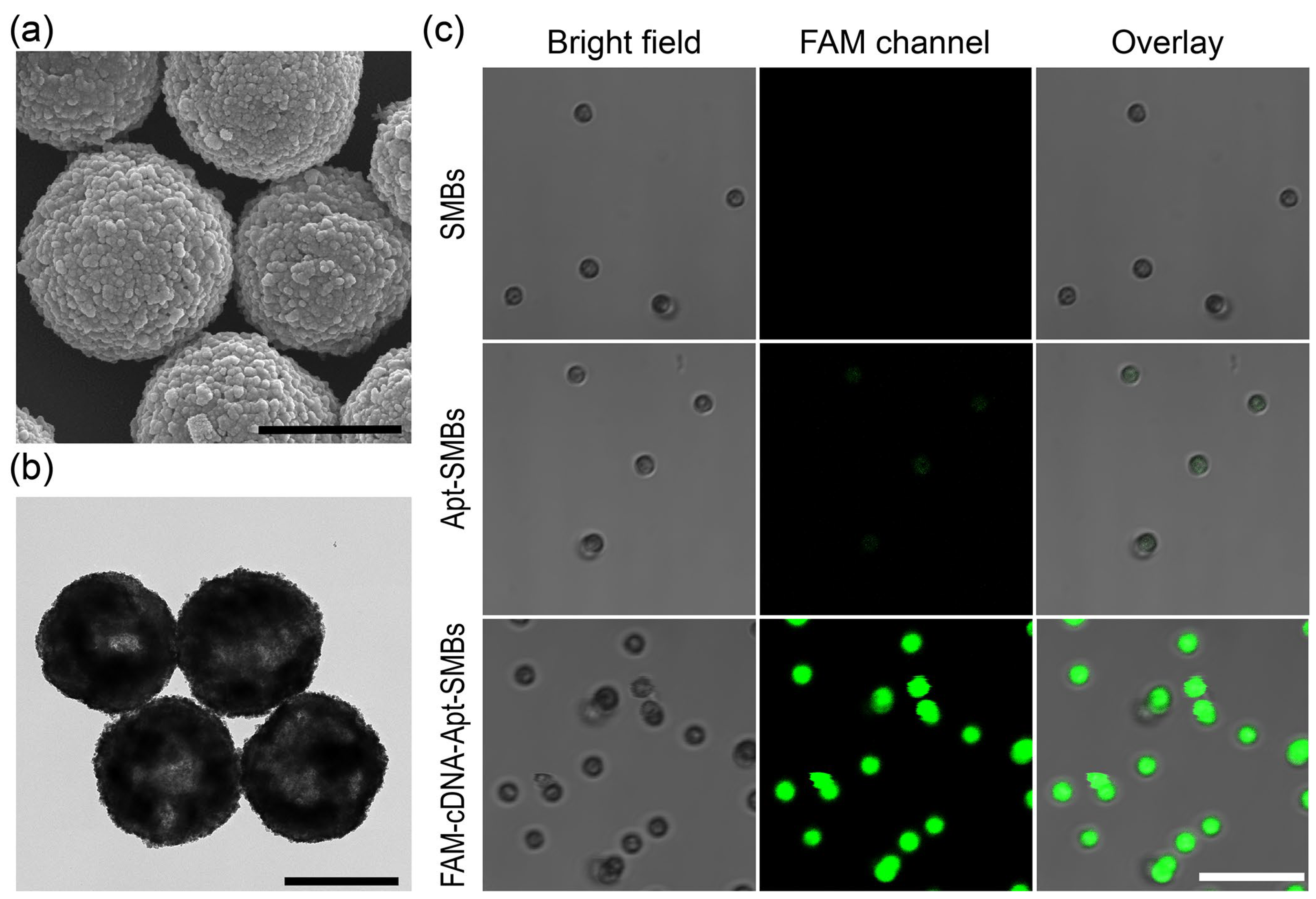
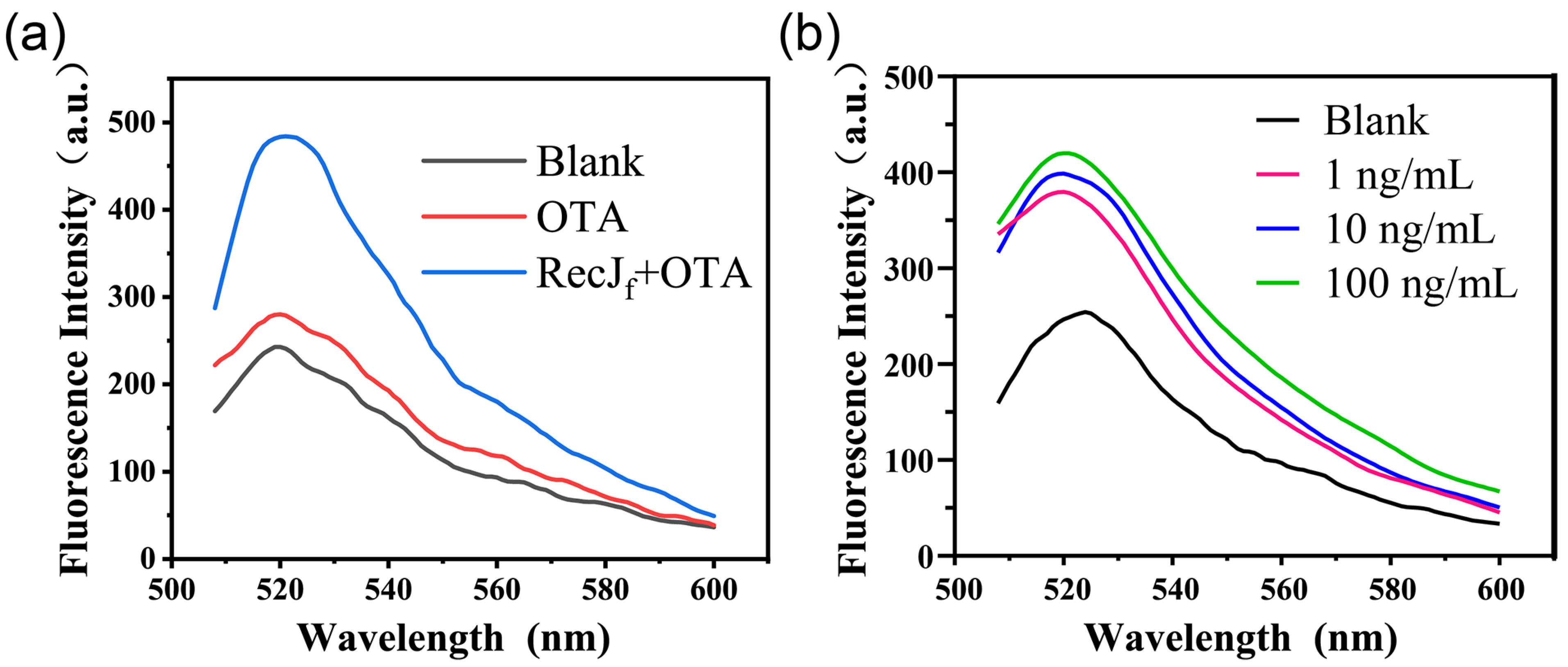
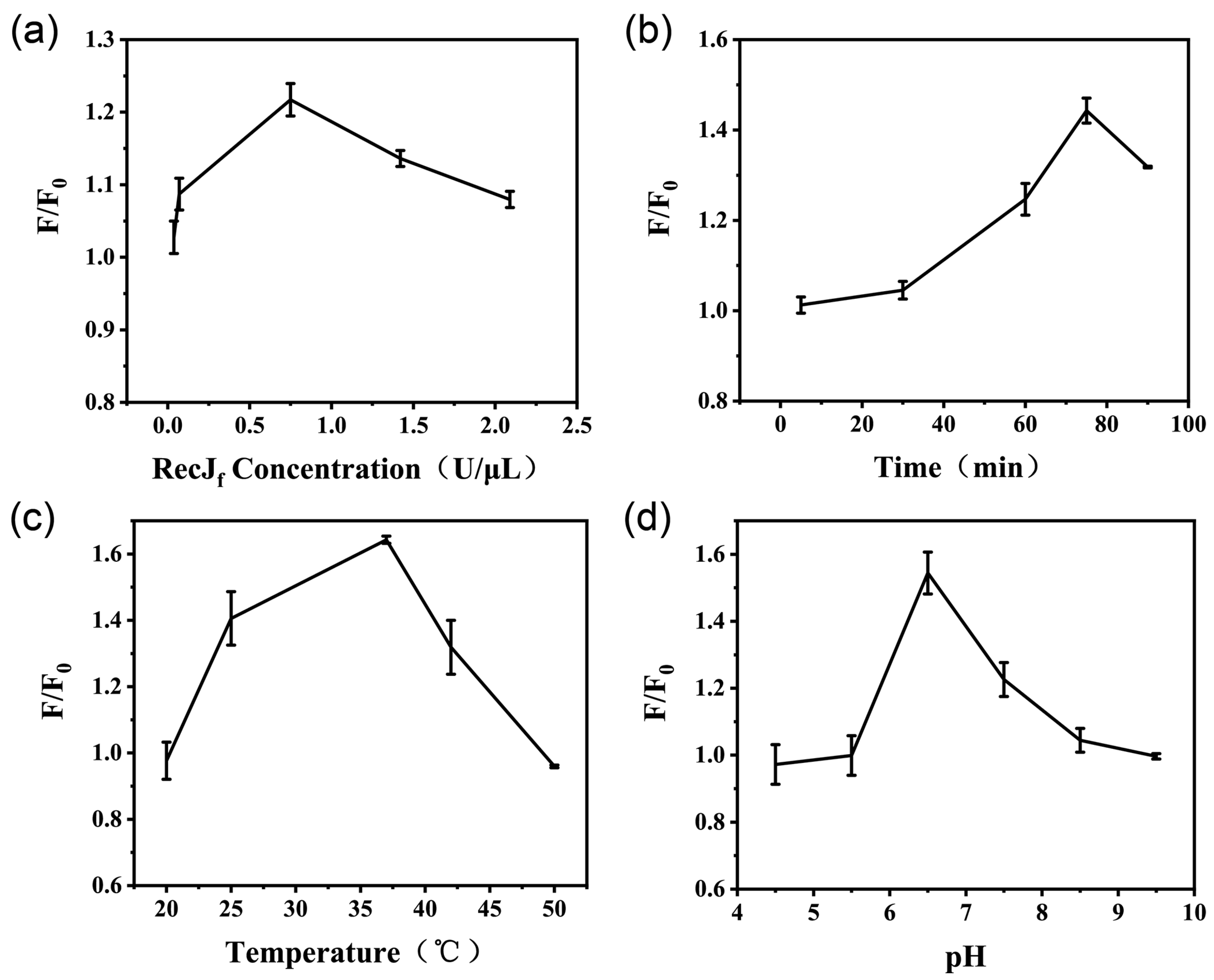
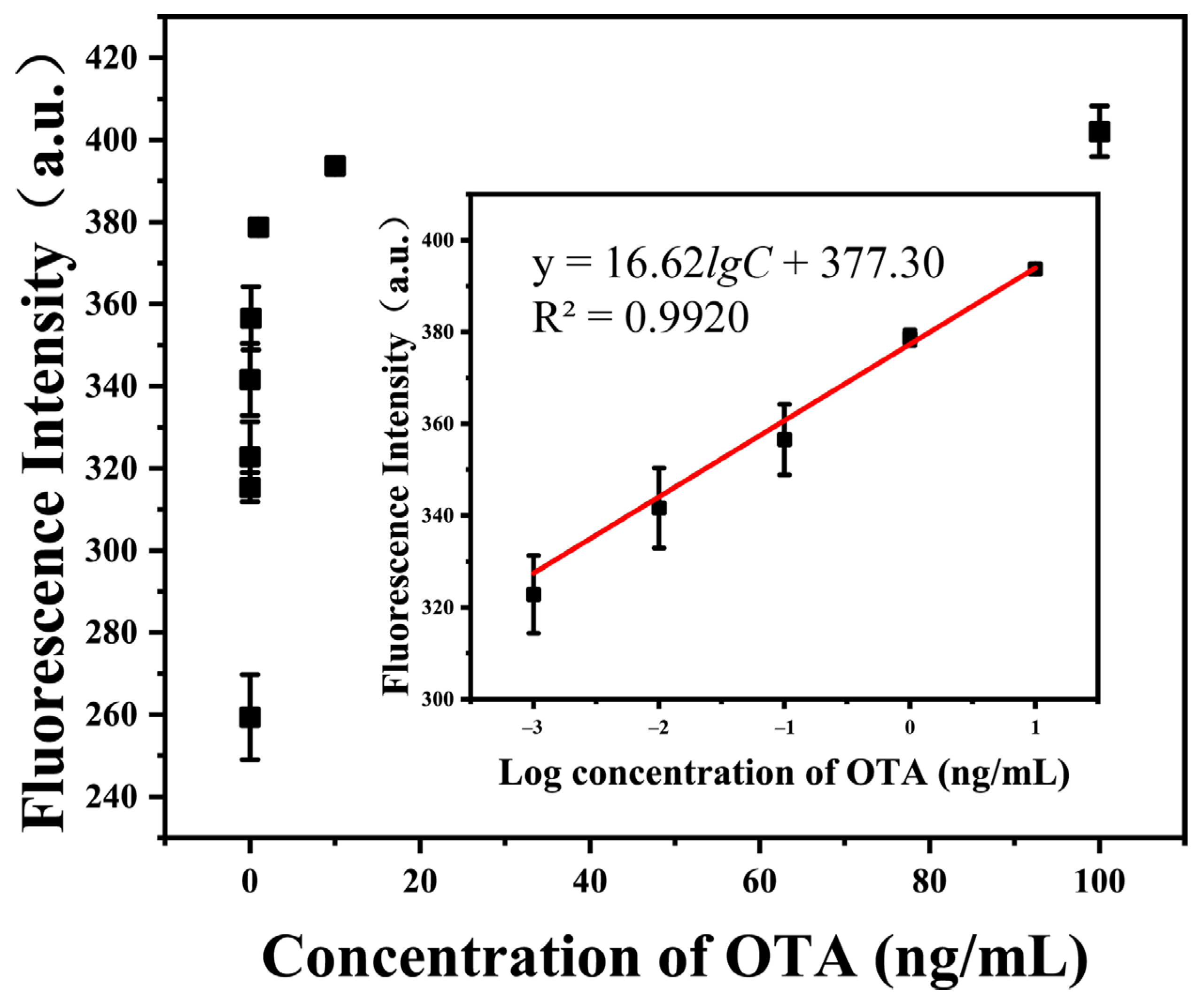
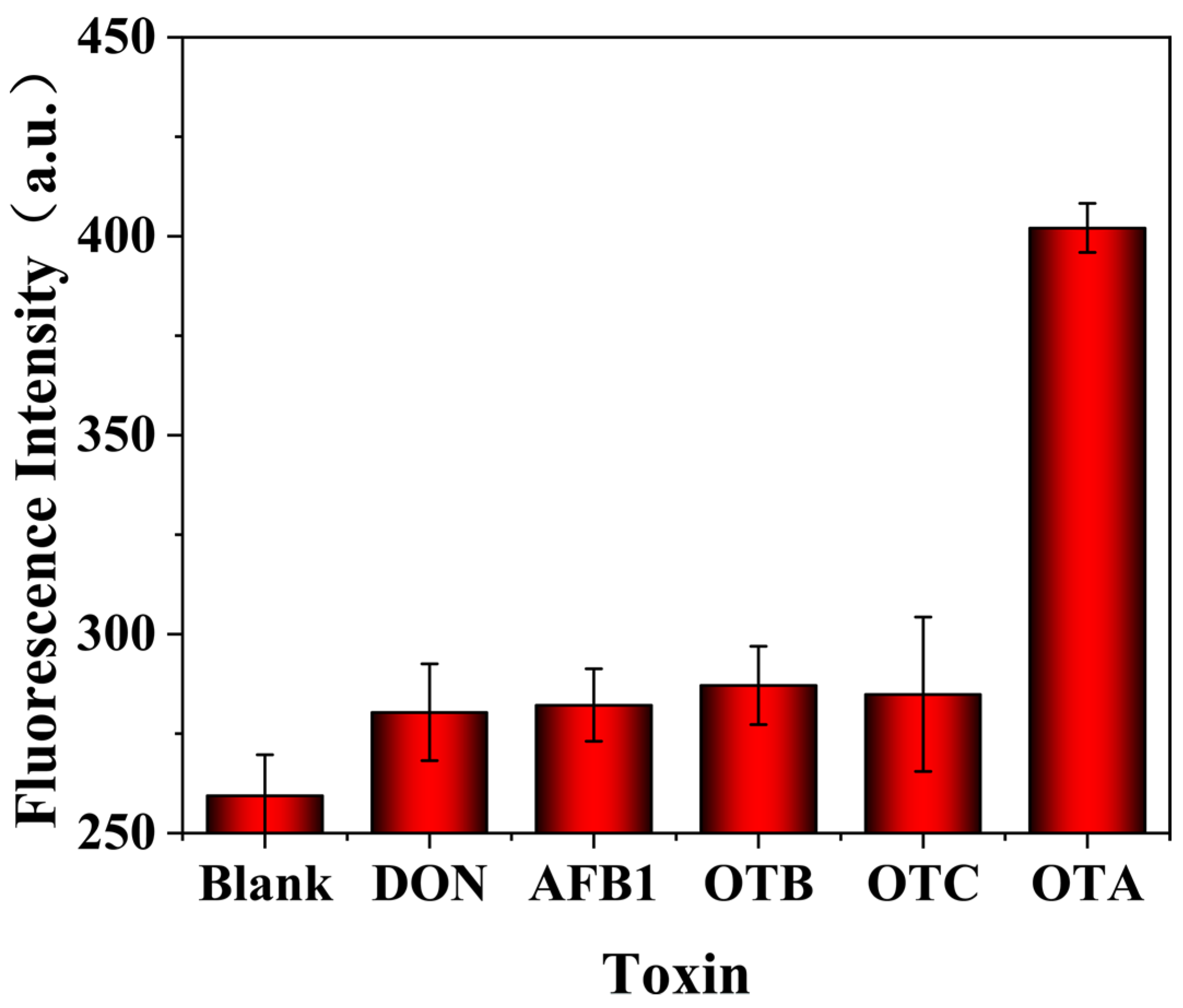
| Sensor for OTA | Linear Range (ng/mL) | LOD (ng/kg) | Matrix |
|---|---|---|---|
| CdSe@CdS quantum dots, electrochemiluminescence aptasensor [24] | 0.5–75 | 1780 | Lily and rhubarb |
| Rolling circle amplification, DNA hydrogel sensor [25] | 0.05–100 | 20 | Beer |
| Cu2O@Fe(OH)3 nanocages, antibody-based immunosensor [26] | 0.001–10 | 0.56 | Millet and lake water |
| Hairpin-DNA-assisted electrochemical aptasensor [27] | 0.03–10 | 13.3 | Corn and wheat |
| DNAzyme amplified aptasensing platform, glucose meter [6] | 0.001–300 | 0.88 | Red wine |
| AuNSs (gold nanostars), AuNPs, SERS aptasensor [28] | 0.005–0.25 | 20.6 | Wine and coffee |
| RecJf exonuclease-assisted fluorescent aptasensor (this work) | 0.001–10 | 6.2 | Wheat and corn |
| Samples | Added (μg/kg) | Our Method | ELISA Method | ||||
|---|---|---|---|---|---|---|---|
| Detected (μg/kg) | Recovery (%) | RSD (%) | Detected (μg/kg) | Recovery (%) | RSD (%) | ||
| Wheat flour | 20.0 | 21.21 | 106.0 | 8.0 | 20.91 | 104.6 | 5.1 |
| 2.0 | 2.19 | 109.3 | 3.5 | 1.63 | 81.6 | 17.0 | |
| 0.2 | 0.20 | 101.3 | 2.4 | Nd | |||
| Corn flour | 20.0 | 16.74 | 83.7 | 2.5 | 19.71 | 98.6 | 0.8 |
| 2.0 | 1.92 | 96.1 | 6.8 | 1.97 | 99.0 | 10.3 | |
| 0.2 | 0.18 | 90.5 | 3.9 | Nd | |||
Disclaimer/Publisher’s Note: The statements, opinions and data contained in all publications are solely those of the individual author(s) and contributor(s) and not of MDPI and/or the editor(s). MDPI and/or the editor(s) disclaim responsibility for any injury to people or property resulting from any ideas, methods, instructions or products referred to in the content. |
© 2024 by the authors. Licensee MDPI, Basel, Switzerland. This article is an open access article distributed under the terms and conditions of the Creative Commons Attribution (CC BY) license (https://creativecommons.org/licenses/by/4.0/).
Share and Cite
Li, Y.; Shao, F.; Wu, J.; Liu, M.; Cao, G.; Zhao, Z.; Bai, J.; Gao, Z. Ultrasensitive Ochratoxin A Detection in Cereal Products Using a Fluorescent Aptasensor Based on RecJf Exonuclease-Assisted Target Recycling. Foods 2024, 13, 595. https://doi.org/10.3390/foods13040595
Li Y, Shao F, Wu J, Liu M, Cao G, Zhao Z, Bai J, Gao Z. Ultrasensitive Ochratoxin A Detection in Cereal Products Using a Fluorescent Aptasensor Based on RecJf Exonuclease-Assisted Target Recycling. Foods. 2024; 13(4):595. https://doi.org/10.3390/foods13040595
Chicago/Turabian StyleLi, Yanxuan, Furong Shao, Jin Wu, Mingzhu Liu, Gaofang Cao, Zunquan Zhao, Jialei Bai, and Zhixian Gao. 2024. "Ultrasensitive Ochratoxin A Detection in Cereal Products Using a Fluorescent Aptasensor Based on RecJf Exonuclease-Assisted Target Recycling" Foods 13, no. 4: 595. https://doi.org/10.3390/foods13040595
APA StyleLi, Y., Shao, F., Wu, J., Liu, M., Cao, G., Zhao, Z., Bai, J., & Gao, Z. (2024). Ultrasensitive Ochratoxin A Detection in Cereal Products Using a Fluorescent Aptasensor Based on RecJf Exonuclease-Assisted Target Recycling. Foods, 13(4), 595. https://doi.org/10.3390/foods13040595






